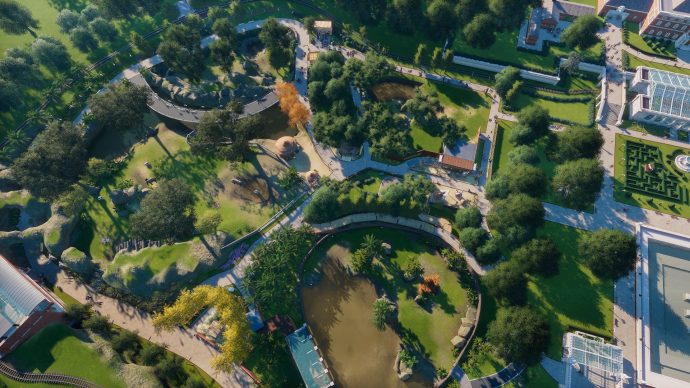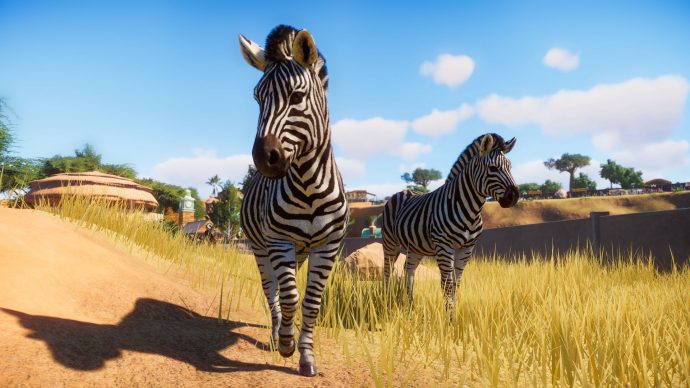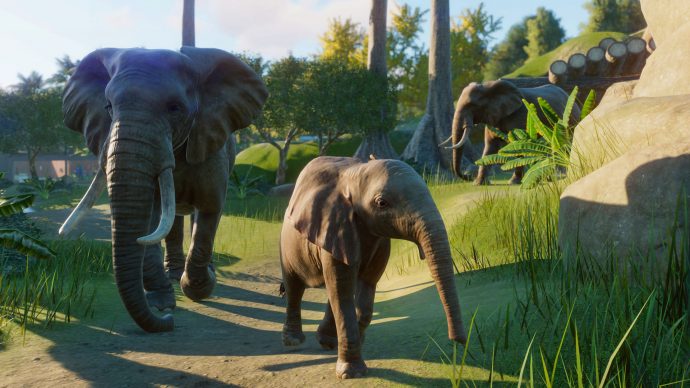Planet Zoo is a promising zoo game and an exhilarating philosophical nightmare
From the makers of Planet Coaster
They say you should never ask how the sausage is made, but in the case of Frontier's Planet Zoo, knowing how the game's creatures were created makes all the difference. Specifically, it's the difference between two kinds of game. On the one hand, a handsome, top-down management sim in which players breed and nurture pleasingly unruly animals for the delight and education of a rosy-cheeked NPC horde. And on the other, a wrenching Lynchian allegory for the ways in which animals are warped, faked, duplicated and optimised within systems of capital. All of which is quite a lot to swallow just before dinner time, I know. So let's start with something relatively easygoing: the humble hippo.
Planet Zoo has many hippos, and they are glorious to behold and listen to. Zoom the camera on one and you'll hear the crunch of its feet on grass, the air coursing through its submarine ribcage, the dusty, prehistoric creak of its hide. The game is committed to capturing the ambience of a zoo – intriguingly, it often seems more preoccupied with that ambience than the animal habitats most zoos seek to emulate – but as regards such small, intricate sounds, Frontier has exercised a little license. When the developer's audio engineers set out to record animals at actual zoos, they found that all they could hear was the human onlookers. “It puts us in this difficult position - trying to be authentic, but giving these animals presence in the space,” Jim Croft, head of audio, tells me during my studio visit. “So how do we do that?” The answer, he goes on, is “hyperrealism” - a term with philosophical connotations of which Frontier's developers seem totally unaware, even as Planet Zoo puts many of those connotations into practice.
Hyperrealism as described by Croft and lead audio designer Matthew Florianz is something specific to audio capture. It covers techniques and technologies such as shotgun mics that are used to home in on a subject and isolate minute sounds – as Florianz puts it, “to get really close to the animal without getting really close to the animal”. Hence the delicate organic symphony that is the game's hippo, lifted above the burble of the crowd. The twist is, you aren't hearing hippo noises. You're hearing audio technicians punching pieces of Xmas tree with boxing gloves to recreate half-ton footfalls, slowed-down human breathing and the artful rumpling of a leather coat, all of it recorded on a Foley sound stage. Actual zoo animals, you see, are inconvenient source material for any audio team striving for that extra level of finesse: the detail of their mouth, limb and bowel movements is smeared and smudged together as the animal goes about being, well, a living thing.
Nor are the game's hippo sounds all specific to the recreation of the hippo: for greater efficiency, Frontier has created libraries of assets that cover several animals. “We don't do [the sound of] elephant skin, we do leathery skin, or feathery skin, or rough skin, and then the animals that need that get the right skin.” Croft says. “And then the footsteps, we do small, medium and large hooves, we do claws.” Thus, when you hear hippos move about you are also, in a way, hearing rhinos or elephants. The only noises that are “typically” recorded from living creatures, and specific to those creatures, are their calls - and this is as much in the service of the game's UI as giving each creature “presence”. Animal calls are an important part of Frontier's efforts to put across information about the animals diegetically, though there's a fearsome quantity of Sims-style mood and physiological status gauges to fall back on. Pull the view back out, and with a little practice, you should be able to deduce the overall health of your zoo by ear alone.
The game's methods of recreating sounds are hardly, of course, unprecedented – pretty much every celebrated sound effect in the industry has its origins in technicians horsing about with sacks of props. But in a simulation that sets such store by the authenticity and liveliness of its creatures, the contrast between what you're hearing and what you think you're hearing is deeply eerie. Which brings us to the other, more famous definition of hyperrealism, as given by the sociologist Jean Baudrillard: a reality so overtaken by symbols and signs that the distinction between real and unreal becomes quaint and irrelevant. To crudely summarise an elaborate argument, Baudrillard identifies a number of stages prior to the emergence of total hyperreality. The penultimate one is characterised by representations that are notionally of something, but are actually free-floating signifiers, copies with no original. It feels like that's where we are with Planet Zoo, a game whose commitment to “giving animals presence” paradoxically obliges its developer to go beyond the animal - to create a version of it better suited to both the game's artistic aims and production constraints. A game in which the very term “hyperrealism” has been cut loose from its philosophical associations, reduced to a question of technique.
This may sound rather damning. On the contrary, I find Planet Zoo utterly fascinating, and I'm looking forward to playing it. Beyond the overarching concept of the hyperreal (which Baudrillard traces, amongst other things, to the segregation of humans from nonhuman beings), the game is an unwitting and useful study of what happens to animals when subject to an institution that views them simultaneously as passive commodities and proud wild creatures with some kind of agency. Frontier has done its damndest to bridge that unbridgeable divide, drawing upon consultation with boffins at nearby Cambridge University. Rather than just sets of gauges, it wants you to think of the game's animals as complex, active and responsive beings, with hundreds of animations and a sprawling tree of behaviours that factors in everything from the temperature to how exposed the creature feels to the thickness of the grass in its enclosure.
Besides basic requirements like the right sort of food, clean water and a place to sleep, each zoo animal has a particular set of social drives. Zebras, for example, like to form herds – a source of serious headaches for the AI programmers, as they laboured to prevent animals walking through one another or sitting in the same place. Tigers, meanwhile, prefer to be housed alone or with a single mate. Even tiny beasts, like Brazilian wandering spiders, have preferences about how many individuals they share a box with together with desired levels of heat, light and foliage. You aren't obliged to heed these drives, providing you can compensate for the ensuing discontent and its effect on your ticket sales, and there's the striking prospect of creatures resolving certain situations without your intervention. If there are two male lions in a pride, for instance, they'll duke it out till one is driven to the periphery of the area.
To all this, add the complications of user-generated terrain. Players can resize, sculpt and furnish each enclosure to taste, gouging out water holes, adjusting barrier heights and materials (which include one-way glass walls, for those intimate moments with beasts in their lairs) and dusting hillsides with biome-specific vegetation. This has obliged Frontier to create one of the management genre's more sophisticated pathing systems, so that zebras can get to water even if you slap a massive deadfall in their way. The developer has also put together a bevy of procedural animation tricks to ensure that, for example, your tiger's back legs don't waggle in mid-air when it's walking up a slope. I was shown a “stress test” enclosure for all this that consisted of a towering marble coliseum, where hapless lions plodded about like the protagonists of early '90s maze games. Players will be free to erect equally silly structures in the finished game.
Each animal is an individual, Frontier says, with its own life history and genetic inheritance that may affect its behaviour. Zoom the camera once more and you'll see this writ large in distinctive markings, proportions and scars (whether from intra-species duels, or because you've allowed a predator to slip your clutches and munch on a few antelopes). Zoom even closer, and you'll see traceries of dirt, fur slicked down by water, the sunlight dancing inside a lion's iris. As with the audio design, the aim is as much to elegantly convey useful information as to gratify your senses. But you'll also notice that your animals don't have genitals, though they are capable of breeding, because Planet Zoo is, after all, a Nice Game, for gamers of all ages. On the one hand, this speaks to the draconian control human beings have exerted over animal reproduction since history began, though I doubt that was the aim. On the other, it's one of many, fascinating places where the game's vaunted authenticity implodes, representation devours original, and we slide back into the waters of the hyperreal.
Similar inconsistencies inform the choice and duplication of animations between creatures. Setting out to make every zoo denizen unique is all very well, but there are resource limitations to think of, both in terms of developer labour and hardware capability. Accordingly, many creatures share a base set of animations that are “retargeted” between species and fine-tuned afterwards. It's not just that your hippo isn't really making hippo noises, in other words, or that it has the same skin as an elephant; it's that at the level of joint and tendon, it's actually a camel.
Doing this has allowed Frontier to free up time and effort for costly bespoke animations, such as chimps grooming one another or the rough-and-tumble of cubs at play. These are, in theory, the points in the game where individual animals are most alive, most “themselves”. The thing is, the lion's share of those bespoke behaviours are apparently derived from portrayals of animals in TV and film, and subject to the same cultural pressures that forbid the rendering of zebra willies in family-friendly media. “I think a lot of people are unwitting experts on animal behaviour,” says Chris Marsh, lead animator. “Everybody's seen Planet Earth and David Attenborough documentaries. Without realising it we tend to know and understand a lot about how animals behave. So it's picking out those points that people recognise from nature documentaries.” This reflects the broad principle that “when people decide whether something's believable or not, it's whether it's meeting their expectations.”
Amongst other things, this emphasis on reality fitting what people expect seems exhilaratingly at odds with Planet Zoo's core theme of education. Guests enter the park as blank tablets, thirsty for zoological trivia. Devote staff and resources to research animals, and you can fill out a Zoopedia with choice factoids that are communicated to those guests by signs and speakers. This boosts each guest's individual education level, with animals that are not native to that zoo's geographical region objects of particular curiosity; it also raises the education level of your zoo as a whole.
The pedagogic focus sits alongside a cautious acknowledgement of the European zoo's stature as a monument to empire, a place where the spoils of conquest were and are gathered and displayed. Frontier has hired a consultant company to check over the representational politics of its African zoo theme, which in the words of senior artists Fearn Hilborn and Liesa Bauwens, strives for the “more whimsical” and “vibrant” feel of a mud-walled village (there's also a classic Victorian theme that deals in white limestone and glass conservatories). When I ask for specifics, however, I'm told this is a question for the publisher. Game director Piers Jackson suggests that “modern zoos have moved on” from their imperial heritage, adding that Frontier wants to depict “an idealistic zoo” and explore the forms zoos take in countries outside Europe. “This is about conservation, this is about breeding animals and looking after them, as opposed to creating something that is quite old-world and colonialist.”
Jackson's suggestion that the zoo's colonialism is firmly a thing of the past gives me pause, but it all sounds very well-intentioned. All the same, I'm more interested in art that explores the tacit cruelties and hypocrisies expressed by the zoo than art which looks to redeem it. Individual zoos can be a force for good, places where caring people try to shelter nonhuman creatures from a relentlessly uncaring world, but the whole concept of the zoo is exploitative and tokenistic. It accommodates animals on condition that they attract paying customers, and deform to fit both the zoo's resource constraints and the expectations those customers bring with them. The process of Planet Zoo's creation – in which hippos dance to the beat of a man punching Xmas trees - is a model for the cataclysmic, hyperreal fuckery of zoos in general. I find that creative process a lot more worthy of discussion than the game at the other end of it, but then, the latter is required for the former to exist.







